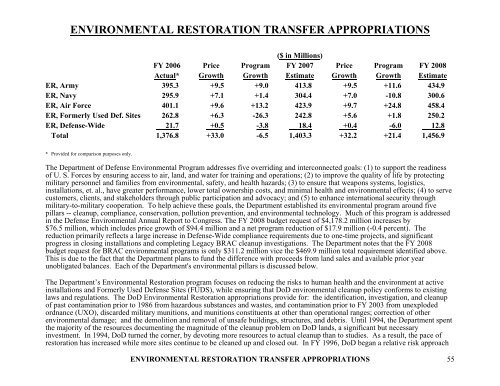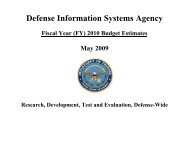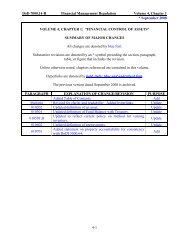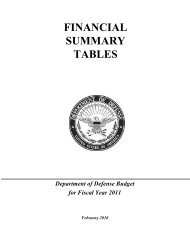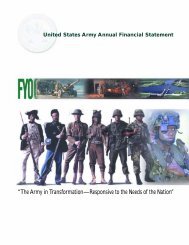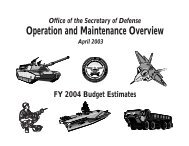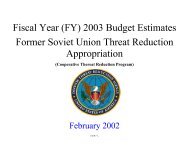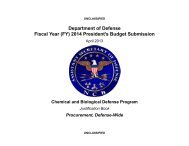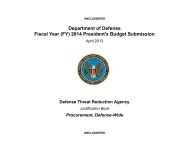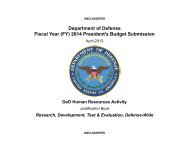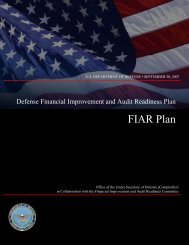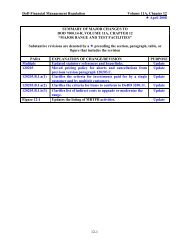Download - Office of the Under Secretary of Defense (Comptroller)
Download - Office of the Under Secretary of Defense (Comptroller)
Download - Office of the Under Secretary of Defense (Comptroller)
You also want an ePaper? Increase the reach of your titles
YUMPU automatically turns print PDFs into web optimized ePapers that Google loves.
ENVIRONMENTAL RESTORATION TRANSFER APPROPRIATIONS<br />
($ in Millions)<br />
FY 2006 Price Program FY 2007 Price Program FY 2008<br />
Actual* Growth Growth Estimate Growth Growth Estimate<br />
ER, Army 395.3 +9.5 +9.0 413.8 +9.5 +11.6 434.9<br />
ER, Navy 295.9 +7.1 +1.4 304.4 +7.0 -10.8 300.6<br />
ER, Air Force 401.1 +9.6 +13.2 423.9 +9.7 +24.8 458.4<br />
ER, Formerly Used Def. Sites 262.8 +6.3 -26.3 242.8 +5.6 +1.8 250.2<br />
ER, <strong>Defense</strong>-Wide 21.7 +0.5 -3.8 18.4 +0.4 -6.0 12.8<br />
Total 1,376.8 +33.0 -6.5 1,403.3 +32.2 +21.4 1,456.9<br />
* Provided for comparison purposes only.<br />
The Department <strong>of</strong> <strong>Defense</strong> Environmental Program addresses five overriding and interconnected goals: (1) to support <strong>the</strong> readiness<br />
<strong>of</strong> U. S. Forces by ensuring access to air, land, and water for training and operations; (2) to improve <strong>the</strong> quality <strong>of</strong> life by protecting<br />
military personnel and families from environmental, safety, and health hazards; (3) to ensure that weapons systems, logistics,<br />
installations, et. al., have greater performance, lower total ownership costs, and minimal health and environmental effects; (4) to serve<br />
customers, clients, and stakeholders through public participation and advocacy; and (5) to enhance international security through<br />
military-to-military cooperation. To help achieve <strong>the</strong>se goals, <strong>the</strong> Department established its environmental program around five<br />
pillars -- cleanup, compliance, conservation, pollution prevention, and environmental technology. Much <strong>of</strong> this program is addressed<br />
in <strong>the</strong> <strong>Defense</strong> Environmental Annual Report to Congress. The FY 2008 budget request <strong>of</strong> $4,178.2 million increases by<br />
$76.5 million, which includes price growth <strong>of</strong> $94.4 million and a net program reduction <strong>of</strong> $17.9 million (-0.4 percent). The<br />
reduction primarily reflects a large increase in <strong>Defense</strong>-Wide compliance requirements due to one-time projects, and significant<br />
progress in closing installations and completing Legacy BRAC cleanup investigations. The Department notes that <strong>the</strong> FY 2008<br />
budget request for BRAC environmental programs is only $311.2 million vice <strong>the</strong> $469.9 million total requirement identified above.<br />
This is due to <strong>the</strong> fact that <strong>the</strong> Department plans to fund <strong>the</strong> difference with proceeds from land sales and available prior year<br />
unobligated balances. Each <strong>of</strong> <strong>the</strong> Department's environmental pillars is discussed below.<br />
The Department’s Environmental Restoration program focuses on reducing <strong>the</strong> risks to human health and <strong>the</strong> environment at active<br />
installations and Formerly Used <strong>Defense</strong> Sites (FUDS), while ensuring that DoD environmental cleanup policy conforms to existing<br />
laws and regulations. The DoD Environmental Restoration appropriations provide for: <strong>the</strong> identification, investigation, and cleanup<br />
<strong>of</strong> past contamination prior to 1986 from hazardous substances and wastes, and contamination prior to FY 2003 from unexploded<br />
ordnance (UXO), discarded military munitions, and munitions constituents at o<strong>the</strong>r than operational ranges; correction <strong>of</strong> o<strong>the</strong>r<br />
environmental damage; and <strong>the</strong> demolition and removal <strong>of</strong> unsafe buildings, structures, and debris. Until 1994, <strong>the</strong> Department spent<br />
<strong>the</strong> majority <strong>of</strong> <strong>the</strong> resources documenting <strong>the</strong> magnitude <strong>of</strong> <strong>the</strong> cleanup problem on DoD lands, a significant but necessary<br />
investment. In 1994, DoD turned <strong>the</strong> corner, by devoting more resources to actual cleanup than to studies. As a result, <strong>the</strong> pace <strong>of</strong><br />
restoration has increased while more sites continue to be cleaned up and closed out. In FY 1996, DoD began a relative risk approach<br />
ENVIRONMENTAL RESTORATION TRANSFER APPROPRIATIONS 55


